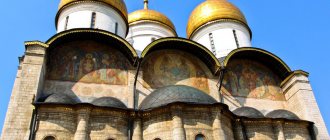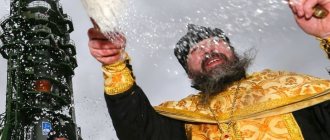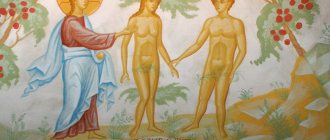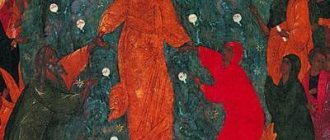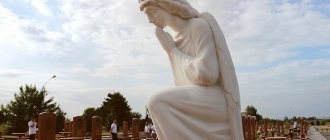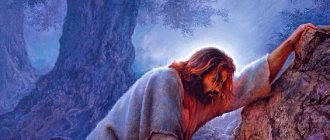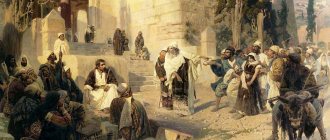| The creation of Adam and Eve. Expulsion from Paradise |
Adam and Eve
, the first people, the ancestors of the human race. Memory on the Sunday of the Holy Forefathers and on the Sunday of the Holy Fathers [1].
The word "Adam" is from the Hebrew adam letters. - red
, associated with adamah - earth, originally, apparently, red soil.
In the Bible, the word “Adam” is used in different senses: “man” (Gen. 5:2), “man” (Eccl. 7:28), “everyone” (Num. 19:14), “everyone” (Zech. 13:5), “people” (Judges 16:7), “first man” (Job 15:7), and also as a proper name. It is included in the expression “sons of Adam
,” which never means the immediate descendants of the first man. They can be called “people” (in the synodal translation “sons of men”) (Prov. 8:31; Ps. 44:3). Used in the singular (lit. “son of Adam”), it denotes a specific person (Ezek. 2:1) or anyone (Jer. 49:18).
Creation of the first people
Adam was created "from the dust of the ground"
(Gen. 2:7), therefore he is “earthly” (1 Cor. 15:47).
God “breathed into his nostrils the breath of life, and man became a living soul”
(Gen. 2:7). Adam was created as a spiritual-physical being, who is the bearer of the image of God Himself (Gen. 1:27). According to the Divine creative plan, he must also be like God (Gen. 1:26). This similarity, unlike the image, is not given, but is assigned to a person and must be realized by him throughout his entire life.
About the creation of the wife of the book. Genesis narrates twice, briefly: “And God created man... male and female he created them” (Gen. 1:27), and in more detail: “... for man there was not found a helper like him. And the Lord God caused the man to fall into a deep sleep; and when he fell asleep, he took one of his ribs and covered that place with flesh. And the Lord God created a wife from a rib taken from a man, and brought her to the man. And the man said, Behold, this is bone of my bones, and flesh of my flesh; she will be called woman, for she was taken from man.”
(Genesis 2:20-23).
| Creation of Eve. Modern icon |
The creation of a wife not independently of her husband, but from his nature (ancient Hebrew sela is not only a “rib” (as in the Synodal translation), but also a “side”, “side” and in general a part of something) emphasizes the duality of man. The Genesis writer himself draws attention to it, deriving the word “wife” (Heb. issah) from the word “husband” (is) (Gen. 2:23). The appearance of a wife is due to the fact that a person had a need for communication. As a bearer of the image of God, he could not remain alone: “it is not good for man to be alone”
(Gen. 2:18); The divine image had to be reflected both in the unity of human nature and in the plurality of hypostases. The creation of a wife is one of the main prerequisites for a person’s life in love, which is an indispensable condition for his “abiding” in God, for “God is love, and he who abides in love abides in God, and God in him” (1 John 4, 16).
The first man is the crown of the world created by God and, as such, has royal dignity, as evidenced by the fact that in the creative act God Himself graciously inhabits man and makes him the ruler of the world (Gen. 1:28). In accordance with his high purpose, man gives names to animals (Gen. 2: 19-20); he is called to “cultivate... and preserve”
the world around us (Gen. 2:15).
However, Adam's perfection was not absolute. It only served as the basis for the fulfillment of his calling and opened up for him the opportunity to become perfect, “as the Heavenly Father is perfect”
(Matthew 5:48).
Accordingly, man’s free will was not perfect, since it could choose not only good, but also evil, as evidenced by the commandment given to man, forbidding him to eat the fruits of the Tree of the Knowledge of Good and Evil (Gen. 2:17). Since only God gives the world He created “life and breath and all things” (Acts 17:25) and only through Him “we... live and move and have our being”
(Acts 17:28), the first man could achieve godlikeness only in unity with By God. Otherwise, he doomed himself to an autonomous, extra-divine existence, which inevitably led to death (Gen. 2:17).
15th century expressionism
We will see the quintessence of despair and fear much later. At the end of the 19th century. By Edvard Munch.
Right: Edvard Munch. Scream (fragment). 1887. Oslo National Museum. Wikimedia Commons.
In fact, Munch, albeit 5 centuries later, came to the same thing. He depicted Fear itself, Despair itself.
And Masaccio invented such a style as expressionism back in the 15th century, long before the same Munch with his “The Scream”.
And now it seems: it would be more logical for art to develop like this, from Fra Angelico to Munch. And in this chain Masaccio is seen closer to the right edge.
But... Masaccio is a brilliant artist who was able to look far into the future. Therefore, he violates logic and stands at the very beginning of this historical chain. Left.
He created an image as if from another era. And his contemporaries were not able to fully understand his innovation. And only you and I can now look at his Eva and say: “How brilliant this is!”
***
If my style of presentation is close to you and you are interested in learning painting, I can send you a free series of lessons by email. To do this, fill out a simple form using this link.
Comments
for other readers,
see below
. They are often a good addition to an article. You can also share your opinion about the painting and the artist, and also ask the author a question.
Author: Oksana Kopenkina
Go to home page
The First Fall and its Consequences
| Adam and Eve. Painting in the catacombs of Saints Peter and Marcellinus in Rome. 2nd half III - 1st half. IV century |
It is not known how long Adam and Eve were in a blissful state of purity and innocence; all that is known is that they lost it. Our first parents could not withstand the temptation they were subjected to from the devil, and committed the first sin, wanting to become like gods without God (Gen. 3:1-6). Adam violated the commandment of God, carried away by his wife, who, seduced by the serpent, ate from the fruit of the tree of the knowledge of good and evil, Adam also ate from it, and by this sin they incurred the wrath of their Creator. The first sign of sin was a feeling of shame, and then a futile attempt to hide from the face of the omnipresent and omniscient God walking around evening time in paradise. Called by God, they expressed their fear and laid down their guilt: Adam - on the wife, and the wife - on the serpent. A terrible punishment befell all those involved in this fall, and in the person of the fallen ancestors the entire human race; however, it was dissolved by the first promise (first gospel) about the Savior of the world, who will be born of a woman: the seed of the woman will erase the head of the serpent
(Gen. 3:15), said the Lord.
As a result of the Fall, their nature underwent significant changes, although they were not of an ontological nature. Sin began to parasitize her, simultaneously preventing the action of Divine grace on her. The first people faced suffering, disease and death. The consequences of their sin affected all of humanity, which inherited from them human nature corrupted by sin, and on the surrounding world, in which, as the biblical narrative says, “thorns and thistles” began to grow (Genesis 3:18).
The first sons of Adam and Eve were Cain and Abel. Cain, out of envy, kills Abel, for which he was expelled and settled separately with his wife and had offspring (Genesis 4).
Little is known about the further life of the first parents: “Adam lived one hundred and thirty [230] years and begat [a son] in his own likeness [and] in his image, and called his name: Seth. The days of Adam after he begat Seth were eight hundred [700] years, and he begat sons and daughters. All the days of Adam’s life were nine hundred and thirty years; and he died" (Genesis 5:3-5).
According to Jewish legend, Adam rests in Judea, next to the patriarchs; according to Christian legend, on Golgotha.
Expulsion from Paradise
The Fall Bosch Jerome.
A cart of hay, left door: Paradise. OK. 1500 Bertram of Minden Master: Grabowski Altar, right inner door, front side. Expulsion from Paradise. OK. 1379 Masaccio. Cycle of frescoes in the Brancacci Chapel in Santa Maria del Carmine (Florence): Expulsion from Paradise. 1425-1428 Hubert van Eyck. Ghent Altarpiece: Adam; Eve. Until 1426-1432 Angelico Fra. Annunciation to Mary When Adam and his companion ate the fruit of the tree of knowledge, they discovered that they were human. “And their eyes were opened, and they knew that they were naked.” They realized that they had a body, and thus a separation of body and consciousness occurred. At the same time they saw that they were a man and a woman, and covered their nakedness with fig leaves. The feminine aspect of Adam, the androgenic angelic being, became isolated in woman. This contradiction - men and women, spirit and body - was posed by the Bible at the beginning of human history.
God forbade man to try the fruits of the tree of the knowledge of Good and Evil: “Do not eat them or touch them, lest you die.” It turns out that the fruits of the tree of knowledge contain
they reap the same poison as Pandora's box, which in Greek mythology brought all the bad things, illnesses and the consciousness of death to the overly curious Greeks.
The folklore interpretation of this mythological motif sees the reason for the punishment of people in the envy of God. In the collection of Hebrew manuscripts of Hathgad, which were written around the same time as the Old Testament, the idea of God's envy of people is expressed in the fact that the god Yahweh personally buries Moses so that no one can find his grave and that the people would honor Yahweh, not Moses. It is the similarity of man with God (his godlikeness) that provokes the wrath of the gods, which we also see in Greek mythology.
We find another explanation for expulsion from paradise when the death that threatens a person is understood not in the physical, but in the spiritual sense. In this case, only Adam dies, since, as an unconscious person, he is practically no different from animals and is in an all-encompassing unity with nature and God. His death is at the same time the birth of man. Just as a child in the act of birth is separated from his mother, with whom he was previously in an inextricable connection, so the hermaphrodite angel Adam is separated from nature. The knowledge that he receives, namely the knowledge of Good and Evil, should be understood not as the acquisition of certain moral ideas, but rather as the awareness of himself as a being who, unlike an animal, can make free choice and act as he wants, and not be completely deterministic. At the same time, knowledge of one’s peculiarity entails suffering and pain. The death of an angel, equivalent to the birth of a person, means that from now on a person must earn his bread by the sweat of his brow and give birth to his children in illness.
The desire of the exiled, who finds himself a stranger in a strange world, is understandable, to regain the lost unity, to return to paradise. The Christian way of finding the lost unity, “union with God,” is to free oneself from all the seductive fetters that connect a person with the material world. God forbade people to eat the fruits of the tree of life, which also stood in paradise. The awareness of yourself, which comes with eating the fruits of the tree of knowledge, also brings awareness of the inevitability of one’s own death. People acquired knowledge, but at the same time became mortal. In Christian mysticism, acquiring divine immortality and overcoming death is equivalent to overcoming the flesh and liberating the spirit.
The feminine principle in Genesis is Eve, “the mother of all who love.” It was she, incited by the serpent, who seduced Adam to taste the forbidden fruits. The cunning animal from the Garden of Eden promised Eve: “No, you will not die. But God knows that on the day you eat them, your eyes will be opened, and you will be like gods, knowing good and evil.” The snake here is a symbol of the wisdom of mothers; its poison can bring death, or maybe cure various diseases. A snake is an animal that does not have arms or legs and therefore can only crawl on the ground; This is the only animal that can bite its own tail, and therefore it is a symbol of eternity. The snake sheds its skin and becomes completely defenseless, but then it grows new skin, and therefore it is a symbol of eternal renewal and rebirth.
And in the Book of Genesis, the snake also speaks with a forked tongue - after all, Adam and Eve, although they become godlike, begin to distinguish between good and evil, but with the awareness of their death, they simultaneously lose their divine immortality.
The element of the snake is earth, matter, which in the sense of Christian teaching opposes the liberation of the spirit from the dungeon of contradictions in which it imprisons itself. “The body is the prison of the soul,” so taught the Orphics, a sect that emigrated from India to Greece. The disintegration of the body, that is, death, should accordingly mean the liberation of the spirit, but not sexuality, as the perpetuation of physical existence. To save the spirit, you need to overcome the foremother Eve, the self-generating snake that renews its skin. A return to unity with God would be tantamount to a state in which the reality of all objects that define human existence is recognized as an illusion.
Another proof of the existence of certain, albeit difficult to comprehend, archetypal ideas of man is that the story of expulsion from paradise is read as an allusion to the Tantric worldview. Here we also see at first the indistinguishable unity of man and woman, body and spirit. This unity breaks down into two polar sexes, and the feminine principle produces the world of phenomena - the transitory "Maya", just like Eve, the foremother of all living things from the Bible. Certain versions of the Indian yoga tradition teach overcoming the contradiction between man and woman, spirit and matter, which is understood as climbing the steps of the process of creation, the process of development of the world in the opposite direction - to the original unity in the act of physical love. Christian mysticism rejects this path, as well as other
some esoteric teachings. According to Christian teaching, returning to unity with God is the path of asceticism, liberation from the shackles of the earthly sensory world, and everyone must follow this path alone.
Expulsion of Adam and Eve from Paradise. Adam and Eve disobeyed God, and He, fearing that they would become like gods by eating the fruit from the tree of life growing in the Garden of Eden, imposed a certain punishment on them and expelled them from paradise. And God declared that because of Eve’s sin, all women in illness would bear their own children and submit to their husbands. Since Adam also sinned, the Lord told him that “by the sweat of your brow you will eat bread until you return to the ground from which you were taken; For you are dust, and to dust you will return” (Gen. 3:19). Adam and Eve earn their daily bread on earth. Adam and Eve, bearing the heavy burden of life on earth and earning their daily bread, as God commanded, “by the sweat of their brow” is a very common plot.
The universal significance of the nature of the first man
The first people, Adam and Eve, are the ancestors of all humanity. There was no other root from which the human race took its beginning, either before or after them. In Gen. 2:5 it is said that before the creation of Adam there was no man to cultivate the land, but in Gen. 3:20 the name of the wife is reported and it is explained that she was called Eve (Hebrew hawwah - life), because she became the mother of all living, that is, the foremother. The unity of the human race is evidenced by the Old Testament genealogies leading from Adam (Gen. 5, 1; 1 Chron 1), and in the New Testament in the genealogy of Jesus Christ, the Evangelist Luke indicates that Christ is not only the Son of God, but also the Son (i.e., a descendant ) Adam (Luke 3:23-38). Finally, Acts tells us that the entire human race was created “of one blood” (Acts 17:26).
The Apostle Paul calls Adam not only “the first man” (1 Cor. 15:47), but also “the image of the future” (Rom. 5:14), meaning the Son of Man, who came to “renew” fallen Adam, “the first” and “early” man (1 Cor. 15:47). The “Second” Man is Jesus Christ; at the same time He is also the “last Adam” (1 Cor. 15, 47, 45). The Apostle, contrasting the first and second Adam, points out that from the “earthly” man a Christian inherits a nature corrupted by sin, the destiny of which is inevitable death, and from the “heavenly” Man (1 Cor. 15:48) - a regenerated nature, the destiny of which is eternal life. “Like the earthy, so are the earthy; and as is the heavenly, so are the heavenly. And just as we have borne the image of earth, we will also bear the image of heaven” (1 Cor. 15:48-49). Thus, being a son of Adam by birth and reborn in Christ, the Christian is in constant connection with the first and second Adam. He is called, according to the words of the same apostle, “to put off his former way of life, the old man, which is corrupted by the deceitful lusts... and to put on the new man, created according to God, in true righteousness and holiness” (Eph. 4:22,24).
About two Adams after the apostle. Paul teaches St. Irenaeus of Lyons, noting that “in the first Adam we offended [God] by not fulfilling His commandments” and “reconciled [with Him] in the Second Adam, “being obedient even to death” [2]. In the Redemption, according to the same St. father, Christ “headed (recapitulavit) all mankind, giving us salvation, so that what we lost in Adam ... we received again in Christ Jesus” [3].
The idea of the universal human nature of the first man was reflected in the patristic and liturgical tradition of the Orthodox Church. Churches. St. Gregory of Nyssa believes that “this name “Adam”... is given to created man not as any one, but as a general race.”
[4].
Trying to understand the pan-human character of Adam’s nature, some Christian thinkers (for example, Vl. S. Solovyov, Archpriest S. Bulgakov) deviated into speculative constructions, as a result of which the first man became more than one (more precisely, the first) hypostasis with a universal human nature , but a multi-hypostatic personality, in which each person, in some incredible way, was already present in his own hypostasis. The anthropological fallacy of such ideas inevitably led to an error in the field of soteriology, to a distortion of the doctrine of original sin and the salvation accomplished by the Second Adam - Jesus Christ.
Traditions about Adam and Eve among different nations
The story of Adam and Eve, with greater or lesser modifications, is preserved in the traditions of almost all ancient peoples, especially the Semitic generation.
The legends of the Zend Avesta among the Persians are similar to the biblical legends about the first man. Ormuzd created the first man from fire, water, air, earth and breathed into him an immortal soul. In the Garden of Eden grows the tree of life - Hôm, the fruits of which give immortality. The vengeful Ahriman in the form of a serpent appears to the ancestors, seduces them and disrupts the happiness of the immortal soul. According to Persian legends, vultures guard the golden mountain.
According to Brockhaus, both Jews and Persians borrowed their legends about the first people from ancient Assyro-Babylonian sources, since identical legends are also found in wedge-shaped inscriptions compiled 2000 years BC, i.e. long before Moses and Zoroaster, and discovered in modern times in the ruins of ancient Nineveh. On one tile from a collection of tiles recovered from the ruins of the Sardanapalus Palace, stored in the British Museum, there is the following fragmentary inscription: “After the gods created living beings, cattle and beasts and creeping things of the field... god (Hao) created two...”.
Here, obviously, we are talking about the creation of the first man, and the Assyrian tradition is thus consistent with Gen. 1, 26-30. We find a similar coincidence between the biblical and ancient Babylonian tradition regarding the legend of the Fall, which in Assyrian sources is even illustrated by bas-relief images. Thus, one bas-relief on a cylinder, also kept in the British Museum, depicts a man and a woman sitting near a tree and stretching out their hands to its fruits. A snake rises from behind the woman. Another bas-relief also represents a tree covered with fruits, surrounded by winged figures. Obviously, the first bas-relief depicts the fact of eating the forbidden fruit, and the second depicts expulsion from paradise and its guarding by cherubim.
Later teachings inherited the ideas about the creation of the world among Jews and Christians, with varying degrees of “creative processing.” Thus, the Koran says that God created the body from clay and the soul from fire. All the angels recognized the new creation, but Eblis alone refused and was expelled from paradise, where Adam settled. Eve was created in paradise. Eblis, out of revenge, seduced the first people, and they were thrown to the ground. God took pity on the repentant Adam and sent the Archangel Gabriel to teach him the commandments of God on the very spot where the temple in Mecca was later built. Adam religiously fulfilled the commandments, for which 2000 years later he found his wife again on Mount Ararat. Adam is buried on Mount Abukai, near Mecca.
Before and after Masaccio
Before Masaccio, only one artist depicted such strong emotions - Giotto. 100 years before, we see despair and grief among the mourning angels over the dead Christ.
Giotto. Lamentation of Christ (detail). 1305. Scrovegni Chapel, Padua. Thetimes.co.uk.
Masaccio continued Giotto's work a century later and tried to depict real drama.
But after Masaccio, things did not immediately work out with emotions for other masters. The Renaissance of the 15th century is more about balance than a storm of passions. It is precisely this calmness that we see in Fra Angelico.
The artist of the next generation, Andrei Mantegna, still tried to work with emotions. However, he was not very convincing. In terms of physiognomy, the facial expressions of his characters are frankly strange.
Mantegna. Christ is the suffering savior. 1488-1500. National Museum Stuten in Kunst, Copenhagen. Wga.hu.
And only Titian managed to portray emotions that Stanislavsky would believe.
Titian. Penitent Mary Magdalene. 1560s. Hermitage, St. Petersburg. hermitagemuseum.org.
However, Titian has one BUT. The despair of a saint... is idealized. Still, Saint Magdalene is beautiful even in her repentance. You wouldn't call Eva Masaccio beautiful. At least her emotions don't color her.
Iconography
| Descent into hell. Dionysius. 1502-1503 |
The images of Adam and Eve are based on the texts of the book of Genesis (Gen. 2, 7-25; Gen. 3, 1-24; Gen. 4, 1-2).
The earliest and most common plot in the monuments of Christ. art - the fall of Adam and Eve, for example: paintings of the catacombs of San Gennaro in Naples, 3rd century, and Saints Peter and Marcellinus in Rome, 2nd half. III - 1st half. IV century; painting of the Dura-Europos synagogue (Syria), ca. 250 g; painting of the tomb of Aurelius in Rome, 3rd century; sarcophagus of Junius Bassus, 359 (Vatican Museums). Naked Adam and Eve are depicted standing at the Tree of the Knowledge of Good and Evil, around which a serpent is entwined. On the sarcophagus of Junius Bassus there is a sheaf of ears of grain next to Adam, and a sheep near Eve, which indicates their labors after expulsion from paradise. Scenes from the story of Adam and Eve are illustrated in detail in miniatures from early manuscripts.
The patristic tradition of comparing Christ with Adam and the legend that Golgotha, where the Savior was crucified, is the burial place of Adam, determined the image of Adam or the head of Adam in the composition “The Crucifixion”. The idea that the blood of the Savior atoned for the sin of Adam is expressed directly in iconography - drops of blood from the wounds of Christ fall on the head of Adam. The image of the head of Adam in the cave under Golgotha has been known since c. [5]. In Byzantine art there are compositions where in the lower part, on the sides of Golgotha, Adam and Eve are depicted rising from the tombs [6]. This detail can be explained by the influence of the iconography of the “Descent into Hell,” known since the 9th century. [7]. Adam appears as a gray-haired old man, in a tunic and himation, Eve - in a red dress and maforia.
Adam and Eve kneeling on either side of the Etymasia (prepared throne) are depicted in the composition “The Last Judgment” [8]. In the image of an elder, Adam is depicted among the Old Testament forefathers and prophets in temple paintings [9].
In Western iconography, the “Crucifixion” type with the half-figure of Adam at the base of the cross has become widespread [10].
Literature
- Malov E., prot. About Adam according to the teachings of the Bible and the teachings of the Koran. Kaz., 1885
- Filaret (Drozdov), archimandrite. [Metropolitan Moscow]. Notes on the book of Genesis. [1816]
- Bogorodsky Ya. A. The beginning of the history of the world and man according to the first pages of the Bible. Kaz., 1902
- Thielicke H. How the World Began: Man in the First Chapters of the Bible. Phil., 1961
- Renckens H. Israel's Concept of the Beginning: The Theology of Genesis 1-3. NY, 1964
- Seraphim (Rose), Hierom. Orthodox understanding of the book of Genesis: Trans. from English M., 1998
- Flemming J. Die Ikonographie von Adam und Eva in der Kunst vom 3. bis zum 13. Jh. Jena, 1953
- Mazure A. Adame et Eve: Le thème d'Adame et Eve dans l'art. P., 1967

